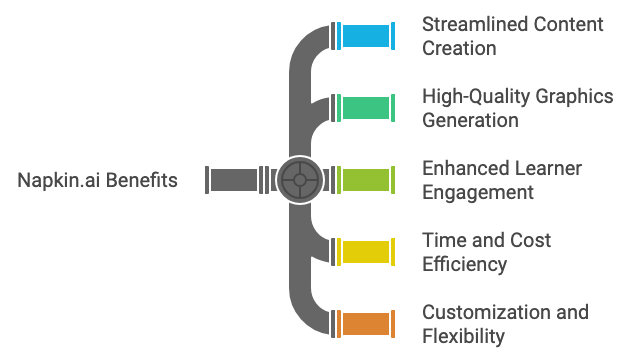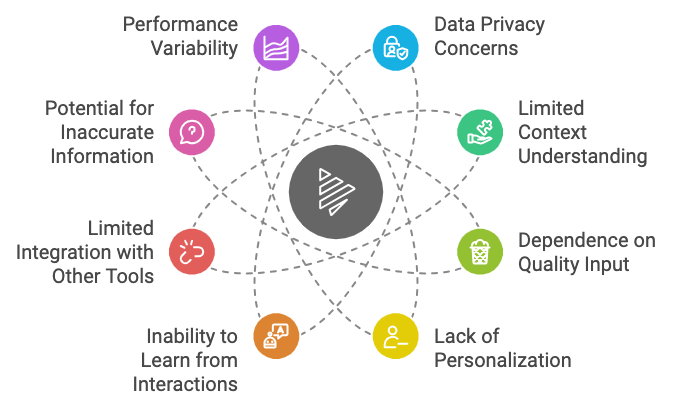
The two charts in this article were produced using napkin.ai in under 30 seconds per graphic using text prompts.
Although there are many AI tools that can assist course creators Napkin.ai has emerged as a powerful tool that simplifies the process of generating high-quality text and graphics, making it an invaluable resource for course creators.
This article explores the benefits of utilizing Napkin.ai in the development of online training courses, highlighting its capabilities in enhancing content quality, saving time, and improving learner engagement.
Something to note is that you can try Napkin.ai free and my suggestion is that you do this before taking out a paid account to make sure that the generating charts and graphics suit your course requirements.
Streamlined Content Creation
One of the primary advantages of using Napkin.ai is its ability to streamline the content creation process. Course developers often face the daunting task of generating informative and engaging text. Napkin.ai leverages advanced AI algorithms to assist in drafting course materials, ensuring that the content is not only relevant but also tailored to the target audience. This efficiency allows educators to focus more on the pedagogical aspects of their courses rather than getting bogged down in writing.
High-Quality Graphics Generation
Visual elements play a crucial role in online training courses, as they can significantly enhance understanding and retention. Napkin.ai offers robust graphic generation capabilities that enable course creators to produce eye-catching visuals quickly. Whether it’s infographics, diagrams, or illustrations, the platform provides a variety of options that can be customized to fit the course’s theme. This feature ensures that the visual content is not only aesthetically pleasing but also informative, thereby enriching the learning experience.
Enhanced Learner Engagement
Engagement is a critical factor in the success of online training courses. Napkin.ai helps course creators develop interactive and visually appealing content that captures learners’ attention. By combining well-crafted text with compelling graphics, educators can create a more immersive learning environment. The platform’s ability to generate diverse content types—such as quizzes, interactive scenarios, and multimedia presentations—further enhances engagement, making the learning process more dynamic and enjoyable.
Time and Cost Efficiency
Developing an online training course can be a time-consuming and costly endeavor. Napkin.ai significantly reduces the time required for content creation, allowing educators to bring their courses to market faster. This efficiency not only saves time but also reduces costs associated with hiring additional content creators or graphic designers. By utilizing Napkin.ai, course developers can allocate resources more effectively, focusing on improving course quality and learner outcomes.
Customization and Flexibility
Every training course has unique requirements, and Napkin.ai offers the flexibility to customize content according to specific needs. Course creators can easily modify text and graphics to align with their instructional goals and branding. This level of customization ensures that the final product resonates with the intended audience, enhancing the overall effectiveness of the training program.
Limitation of Napkin.ai
Note: At the time of writing napkin.ai is still in beta.
While Napkin.ai offers a range of functionalities that can enhance productivity, users should be aware of its limitations to make informed decisions about its application in their workflows.Inability to always recognise whether the output should be a process leading to an outcome, a circular process, a hierarchical structure etc.

- Data Privacy Concerns: Users may be apprehensive about sharing sensitive information with an AI tool, raising concerns about data security and privacy.
- Limited Context Understanding: Napkin.ai may struggle to grasp complex contexts or nuanced instructions, leading to less accurate outputs in certain scenarios.
- Dependence on Quality Input: The effectiveness of Napkin.ai heavily relies on the quality of the input provided. Poorly structured or vague prompts can result in suboptimal responses.
- Lack of Personalization: While Napkin.ai can generate responses based on general data, it may not cater to specific user preferences or styles, limiting its adaptability.
- Inability to Learn from Interactions: Unlike some AI systems that improve over time through user interactions, Napkin.ai may not have the capability to learn and adapt from individual user behavior.
- Limited Integration with Other Tools: Users may find that Napkin.ai does not seamlessly integrate with other software or platforms they use, creating workflow inefficiencies.
- Potential for Inaccurate Information: As with many AI tools, there is a risk of generating incorrect or misleading information, which can lead to misunderstandings or poor decision-making.
- Performance Variability: The performance of Napkin.ai may vary depending on the complexity of the task, with some functions working better than others.
- Resource Intensive: Depending on the scale of usage, Napkin.ai may require significant computational resources, which could be a limitation for smaller operations.
- Limited Language Support: While Napkin.ai may support multiple languages, its proficiency can vary, potentially affecting non-English users.
Conclusion
In conclusion, Napkin.ai stands out as a transformative tool for educators looking to build high-quality online training courses and who want to rapidly generate graphics from their own text or from an AI prompt. Its capabilities in generating text and graphics not only streamline the content creation process but also enhance learner engagement and improve overall course quality. By leveraging Napkin.ai, course creators can save time and resources while delivering compelling and effective training experiences. As the demand for online education continues to grow, tools like Napkin.ai will play a pivotal role in shaping the future of learning.

